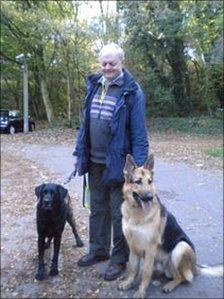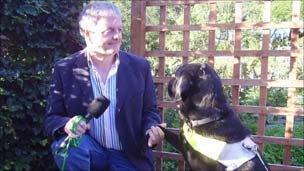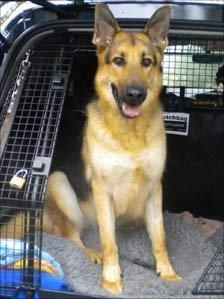Taking the lead with a new guide dog
- Published

Ian had to find a new dog when Moss was forced to retire due to ill health
For the last few months blind BBC Scotland TV and radio reporter Ian Hamilton has been working with his new guide dog Renton.
His last faithful companion, Moss, was forced to retire due to ill health. Ian, who is from South Lanarkshire, has now made a documentary, Born to Lead, which charts him trying to find a worthy replacement for Moss.
One hundred and eighty thousand blind people of all ages in the UK never go out on their own.
This is incredible and shocking I know. That's two in five visually impaired people trapped indoors, reliant on others for their mobility.
This is what I discovered in the making of my documentary "Born to lead" which was shown on BBC1 Scotland on Monday.
Last year when I began the process of applying for a new guide dog, I never anticipated being without a dog for nearly six months and I never expected to have felt so reliant upon others for my mobility.
Last April the vet advised me that due to my 10-year-old guide dog Moss's poor health, arthritis in his hips and the beginnings of cataracts in his eyes, he should retire as soon as possible.
Now Moss has been a really good guide dog, utterly reliable. We both started in the BBC together and got to know our way round the new building.
Devastating news
The actuality of not having such a great guide with me was devastating news, and the reality that I would have to rely on my white cane again, while the hunt started for his replacement, was going to be really difficult to take.

Ian and Moss started in the BBC together
Going out on the street by myself for the first time in years, I realised what a dangerous place our high streets have become for blind people.
Wheelie bins, benches, bollards of all shapes and sizes and crossing lights in the oddest places, all add to the already daunting process of just stepping outside the door.
Remember there are just under half a million blind people in the UK.
I hate using a white stick and always try to avoid using one. For me, the guide dog has always been my chosen form of mobility.
I can move quickly through my environment avoiding all the usual obstacles including pedestrians, who for some reason just love dancing in and around my stick.
A dog will just glide past people easily.
Mobility skills
Surprisingly, only 5% of blind people in the UK use a guide dog, and this something I discuss in my documentary.
Not every blind person wants to put their life into a dogs paws.

Renton has been with Ian for the last few months
I am so used to travelling on my own, but, without a dog, I thought twice before heading out the door.
"Do I really need to go out? If I do, what will I face when I'm out there and what utility company have been digging up the roads and pavements this week? Where have the new holes in the road sprung up?"
I guess I have become so dependent on my dog that I have let other parts of my mobility skill fall away. And yes, for someone who is blind, and I am completely blind, mobility is a skill.
To be fair to the Guide Dogs for the Blind Association, they always recommend keeping up other mobility skills in case the dog cannot work for some reason. This was something I never really did as I just loved using my dogs to get about.
As part of the documentary I explore other alternatives to navigation as I wait for my new dog to become available. I also talk to some well-known blind people who have strong views for and against using a dog to get about.
Born to lead is available on the iplayer. You can also keep up-to-date with Ian and his new dog Renton through his blog, external or by following him on Twitter @IHamiltonbbc
- Published10 February 2011